
|
Keywords: clouds, Jupiter, Moon, ring
 A Lunar Corona with Jupiter and Saturn
A Lunar Corona with Jupiter and Saturn
19.01.2021
Why does a cloudy moon sometimes appear colorful? The effect, called a lunar corona, is created by the quantum mechanical diffraction of light around individual, similarly-sized water droplets in an intervening but mostly-transparent cloud. Since light of different colors has different wavelengths, each color diffracts differently.
 Strawberry Supermoon Over Devils Saddle
Strawberry Supermoon Over Devils Saddle
4.07.2022
Near the horizon the full moon often seems to loom large, swollen in appearance by the famous Moon illusion. But time-lapse image sequences demonstrate that the Moon's angular size doesn't really change as it rises or sets. Its color does, though.
 Meteors Between Stars and Clouds
Meteors Between Stars and Clouds
11.12.2002
Streaking high above diffuse clouds -- but well in front of distant stars -- are sand-sized bits of an ancient comet: meteors. These bits flaked off Comet Tempel-Tuttle during its pass through the inner Solar System about 150 years ago. Far in the background are stars toward the constellation of Ursa Major.
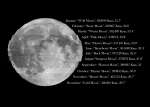 The Full Moon of 2021
The Full Moon of 2021
1.01.2022
Every Full Moon of 2021 shines in this year-spanning astrophoto project, a composite portrait of the familiar lunar nearside at each brightest lunar phase. Arranged by moonth, the year progresses in stripes beginning at the top.
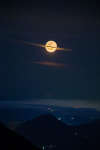 A Moon Dressed Like Saturn
A Moon Dressed Like Saturn
2.08.2022
Why does Saturn appear so big? It doesn't -- what is pictured are foreground clouds on Earth crossing in front of the Moon. The Moon shows a slight crescent phase with most of its surface visible by reflected Earthlight known as ashen glow.
 Find the New Moon
Find the New Moon
25.07.2022
Can you find the Moon? This usually simple task can be quite difficult. Even though the Moon is above your horizon half of the time, its phase can be anything from crescent to full.
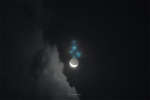 APOD: 2025 April 8 Б Moon Visits Sister Stars
APOD: 2025 April 8 Б Moon Visits Sister Stars
8.04.2025
Sometimes, the Moon visits the Pleiades. Technically, this means that the orbit of our Moon takes it directly in front of the famous Pleiades star cluster, which is far in the distance. The technical...
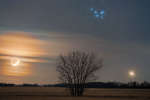 A Cosmic Triangle
A Cosmic Triangle
15.04.2020
It was an astronomical triple play. Setting on the left, just after sunset near the end of last month, was our Moon -- showing a bright crescent phase. Setting on the right was Venus, the brightest planet in the evening sky last month -- and this month, too.
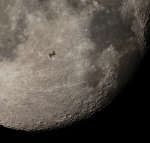 Moon over ISS
Moon over ISS
6.11.2020
Completing one orbit of our fair planet in 90 minutes the International Space Station can easily be spotted by eye as a very bright star moving through the night sky. Have you seen it? The next time you do, you will have recognized the location of over 20 years of continuous human presence in space.
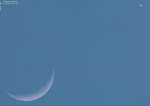 A Conjunction of Crescents
A Conjunction of Crescents
8.02.2025
A waxing crescent Moon and a waning crescent Venus are found at opposite corners of this twilight telephoto field of view. The close conjunction of the two brightest celestial beacons in planet Earth's western evening sky was captured on February 1 from Rosario, Argentina.
|
January February March April May June July |
|||||||||||||||||||||||||||||||||||||||||||||||||